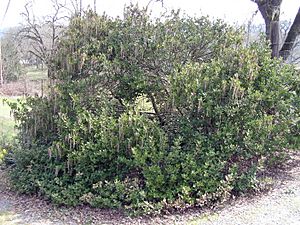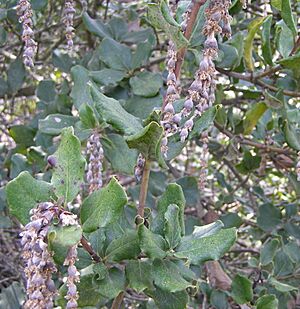Chaparral silktassel facts for kids
Quick facts for kids Congdon silktassel |
|
|---|---|
 |
|
| Congdon silktassel | |
| Scientific classification | |
| Genus: |
Garrya
|
| Species: |
congdonii
|
The Congdon silktassel (Garrya congdonii) is a cool evergreen shrub. It's also called the chaparral silktassel. This plant grows naturally in the northern California Coast Ranges. It belongs to a small plant family called Garryaceae, which has about 20 known species. Most of these species are Garrya plants.
Congdon silktassel plants have separate male and female parts. The male parts hang down like long tassels and are very noticeable. This plant looks nice and grows neatly. Because of this, you can often find it for sale at plant nurseries. All Garrya plants like warm areas in North America.
Contents
What it Looks Like
The Congdon silktassel often grows with many branches from its trunk. This gives it a round, almost ball-like shape. It can grow up to four meters (about 13 feet) tall. But usually, in the wild, it's about two to three meters (6 to 10 feet) tall.
Like all Garrya plants, the Congdon silktassel has leaves that grow opposite each other. They feel tough and leathery. The top of the leaves is glossy green. The underside is paler, a bit fuzzy, and not as shiny.
The plant has separate male and female plants. The flowers grow in long, hanging clusters called aments. These clusters are about three to five centimeters (1 to 2 inches) long. The male flower clusters are much longer, up to 25 centimeters (10 inches) long. They are very easy to see. The female clusters are shorter and look silver-grey.
Even though the flowers bloom in late January and February, their dried parts stay on the tree. They look like light gray decorations well into the summer. The plant's bark is smooth and dark. When it's young, the bark is dark-greenish. As the plant gets older, the bark becomes rougher. New twigs are green and quite strong.
Female flowers have one small flower above each tiny leaf-like part called a bract. This plant makes tiny dark seeds. These seeds can float away on the wind like small fluffy cotton. The ripe fruit is purple to black and about seven millimeters (0.3 inches) wide. It has a hard, dry outer shell but is a bit soft inside. Male flowers have four stamens (the parts that make pollen) in each flower. There are three flowers above each pair of bracts.
The Congdon silktassel has some special features. Its leaves are leathery and curve slightly upwards (convex). They are green with a hint of yellow. The edges of the leaves are wavy. The underside of the leaves has tiny hairs. These hairs are so dense you can barely see them without a magnifying glass. Its leaf blades are six to eight centimeters (2.4 to 3.1 inches) long. The leaf stems (called petioles) are six to twelve millimeters (0.2 to 0.5 inches) long.
To tell it apart from other plants, remember its leaf hairs. You can see them with a magnifying glass. Also, its leaves and leaf stems are about two-thirds the size of those on the Coast silktassel.
Where it Lives
The Congdon silktassel grows in several plant areas. It is mainly found in the drier inner California Coast Ranges. These areas are usually no more than 20 miles from the Pacific Ocean. You can find it in Coastal chaparral (a type of shrubland), Mixed evergreen forest (near chaparral), and Northern coastal sage scrub.
This plant can grow in heavy clay soils and special soils called serpentine areas. It likes soils with a pH level between six and eight. An example of a serpentine soil home is in The Cedars of Sonoma County, California.
Deer or rabbits usually don't eat this plant much. It can also handle cold temperatures, down to about 15 degrees Fahrenheit (minus 9 degrees Celsius). The Congdon silktassel can survive dry periods. However, it grows best with about 22 inches (56 centimeters) of rain each year.
How it's Different from Other Silktassels
You usually find the Congdon silktassel at elevations above 200 meters (about 650 feet). This plant is typically found in the mountains of the inner Pacific Coast range. This includes places like Mount Hamilton and north to the inner coast range in Sonoma County. The Coast silktassel (Garrya elliptica) is its closest relative.
The Coast silktassel has similar wavy leaf edges. Its leaves are darker and shinier. The top of its leaves feels more waxy and less leathery than the Congdon silktassel. The white hairs on the underside of the Coast silktassel's leaves are hard to see even with a magnifying glass. The Coast silktassel often grows as single plants, not in groups. You can find it in the Montara Mountain range, San Bruno Mountain, and outer coastal ranges in Marin County, like Mount Tamalpais.
Both the Fremont silktassel (Garrya fremontii) and Ashy silktassel (Garrya flavescens) have similar fruit. However, their leaf edges are flat, not wavy. The Fremont silktassel has yellow-green leaves and fruits that are almost hairless. It grows from the Mount Hamilton area and Loma Prieta north to Marin County (for example, on Mount Tamalpais). The Ashy silktassel (Garrya flavescens pallida) has grayish leaves. It is found in the Alameda County hills.
Images for kids



